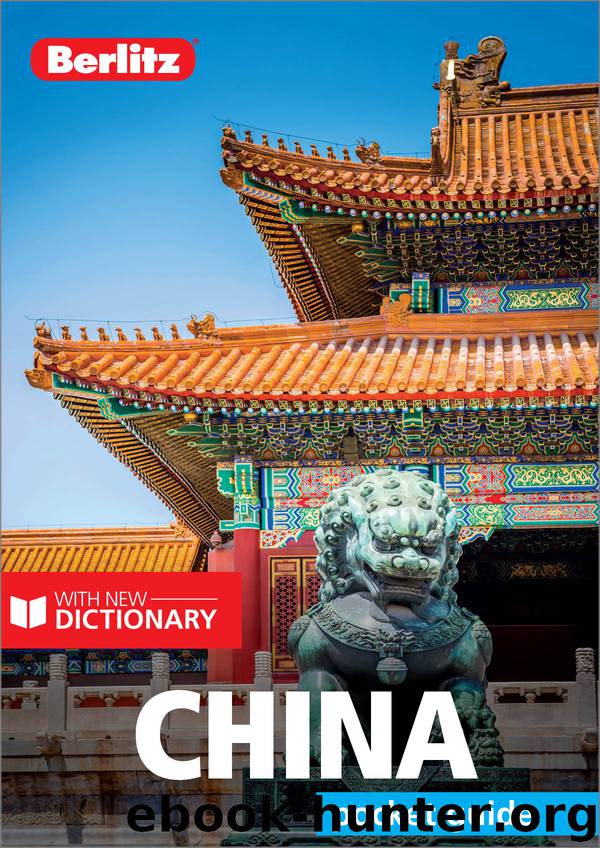Berlitz Pocket Guide China (Travel Guide eBook) by Berlitz Publishing

Author:Berlitz Publishing
Language: eng
Format: epub
Tags: Travel, China
Publisher: Apa Publications
Published: 2019-04-09T16:00:00+00:00
An exhibit in Suzhou’s Silk Museum
David Shen-Kai/Apa Publications
The principal religious site, the Temple of Mystery (Xuanmiaoguan; daily 7.30am–4.30pm winter, 7.30 am–5pm summer; charge), includes the largest early Daoist hall in China (built in 1179) and today is surrounded by Suzhou’s biggest, liveliest outdoor market.
Wuxi
Wuxi, a city 30 minutes by train from Suzhou, means ‘no more tin’, a reference to the depletion, a couple of thousand years ago, of local mines. Wuxi today is a prosperous industrial and marketing centre with a population of 6.5 million, just one light in the Yangzi delta’s constellation of cities. Business parks and large-scale demolition of the older part of town have reduced the urban area’s one-time historic charm. However, canals and rivers still crisscross Wuxi, and the Grand Canal, Wuxi’s prime historic attraction, flows right through the centre of town from Lake Tai, Wuxi’s prime scenic attraction.
Even a short boat ride through the city on the Grand Canal produces unforgettable sights and photos. People may line the bridges (each of a different design) to wave. Human-propelled ferryboats scurry out of the way as long trains of barges, their decks heaped up with onions, reeds or bricks, labour past. The riverside dwellers, who live in quaint whitewashed houses, wash their clothes in the canal.
The Grand Canal project, begun some 2,400 years ago, created an inland waterway stretching 1,794km (1,113 miles) from Beijing to Hangzhou. For more than 2,000 years successive dynasties linked lakes and rivers to create the single canal, 40 paces wide, that went from Hangzhou, across the Yangzi and Yellow rivers, to the old capital Chang’an (now Xi’an) and on to Beijing. In its heyday, some 15,000 junks, sampans and barges plied this watery highway, carrying grain, timber, salt, fish, cloth, pottery and luxury goods.
Today the Grand Canal is used considerably less for commerce and transport. Much of it is not navigable, and some of the water is polluted. But for travellers it can provide an interesting excursion, as local officials from districts along the waterway resuscitate it as a tourist attraction. Canal trips by tourist boat often originate in Suzhou, and chug their way along to Wuxi.
The Grandest of Canals
Download
This site does not store any files on its server. We only index and link to content provided by other sites. Please contact the content providers to delete copyright contents if any and email us, we'll remove relevant links or contents immediately.
Whiskies (Collins Gem) by dominic roskrow(45007)
Spell It Out by David Crystal(36017)
Cecilia; Or, Memoirs of an Heiress — Volume 1 by Fanny Burney(32404)
Cecilia; Or, Memoirs of an Heiress — Volume 3 by Fanny Burney(31804)
Cecilia; Or, Memoirs of an Heiress — Volume 2 by Fanny Burney(31777)
Beautiful Disaster by McGuire Jamie(25225)
Trainspotting by Irvine Welsh(21477)
Chic & Unique Celebration Cakes by Zoe Clark(19928)
The Secret History by Donna Tartt(18797)
How High Can a Kangaroo Hop? by Jackie French(18756)
Twilight of the Idols With the Antichrist and Ecce Homo by Friedrich Nietzsche(18472)
All the Missing Girls by Megan Miranda(15468)
Cat's cradle by Kurt Vonnegut(15140)
Ready Player One by Cline Ernest(14483)
Fifty Shades Freed by E L James(13141)
For the Love of Europe by Rick Steves(12552)
4 3 2 1: A Novel by Paul Auster(12254)
Crooked Kingdom: Book 2 (Six of Crows) by Bardugo Leigh(12195)
Grundlagen Kreatives Schreiben (German Edition) by Helfferich Pia(10379)
